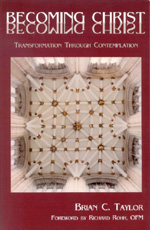In his last book, Setting the Gospel Free, Brian C. Taylor wrote: "The church must now reclaim, grow into, and offer to the world its centuries old minority view, the contemplative way. If we do not make this shift in both awareness and expression, the church will die." The author lives in Albuquerque, New Mexico, where he has been the rector of St. Michael and All Angels Episcopal Church since l983. He is married and the father of two grown sons. This soul-stretching paperback can be read as a companion volume to his first bold work where he set forth a daring vision of Christianity.
In the foreword Richard Rohr, founder of the Center for Action and Contemplation, states: "My suspicion is that our undeveloped theology of the Holy Spirit largely explains our undeveloped attraction to and practice of contemplative prayer." The Holy Spirit leads us into a closer identification with Christ. Or as Taylor puts it, "Jesus promised a quality of life to his followers, which he called the kingdom of God, or the kingdom of heaven. This quality of life is marked by unconditional love (especially for the powerless), forgiveness, peace, honest encounters with evil and injustice, healing, and freedom from all kinds of captivity. As we live into our Christly identity, we experience the kingdom more and more; we experience Christ's life in us to a greater degree."
Contemplative prayer is a gift from God that serves as a pathway for the work of the Holy Spirit within us. Taylor outlines some of the essential components of this devotional practice including body awareness, silence, softening the heart towards God, using a repeated phrase or word to bring ourselves back to attention, and opening our hearts towards God by maintaining a light, spacious, empty awareness. He suggests some time-honored tactics for dealing with involuntary thoughts that arise in prayer. Taylor reassures those who have trouble staying focused in their devotional life by mentioning that no less a spiritual athlete than Teresa of Avila is reported to have said that fifteen minutes of prayer is fourteen minutes of distraction. We all need divine assistance and patience in our communion with God.
Taylor finds the prayer of the heart in many traditions and includes the softening of the heart practiced by Eastern Orthodox monks, the devotion to the Sacred Heart of Jesus practiced by some Catholics, and the work with the heart chakra in Hindu and Chinese Taoist meditation. Writing about the Jesus Prayer, he notes that the holy name has energy to it and invoking the name invokes the presence. The ninth century monk Hesychius of Sinai wrote about this: "The more the rain falls on the earth, the softer it makes it; similarly, the more we call upon Christ's holy Name, the greater the rejoicing and exultation it brings to the earth of our heart."
The second half of the book focuses on the many supports the tradition and resources of the church can provide to help us sustain a private practice of contemplative prayer. These include worship, the daily office, service, giving money, self-denial, the sacrament of reconciliation and study of Christian tradition. Taylor believes that the purpose of faith and prayer is the renewal of our lives. He concludes on this high note: "We are the body of Christ alive in the world, and he is the human face of God. But to manifest Christ in our lives, to reveal him to the world, we must undergo a journey of transformation by which we become him, and he becomes us. Contemplative prayer, practiced with faith and patience, undertaken in the context of the church's life, takes us on this journey into Christ."
